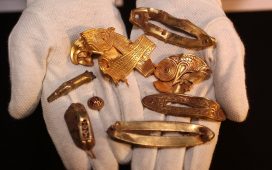Archaeologists have unearthed a 2,300-year-old Celtic sword in France decorated with glass paste and swastika engravings, a discovery shedding more light on weapons manufactured in ancient Europe.
The sword was found at a strange second Iron Age burial site, lacking any skeletons due to the acidity of the soil.
However, researchers uncovered several metal artefacts at the site, including copper alloy bracelets, decorated fibulae made of iron, as well as two swords still in their sheath.
Overall, 18 such fibulae were identified at the site, made mainly of copper alloy or iron, with the “most exceptional” of them embellished with a cabochon gemstone and decorated with a silver leaf motif, they say.
The ornament is attributable to the end of the 4th century or the beginning of the 3rd century BC, according to the French National Institute of Preventive Archaeological Research (INRAP).

After stabilising the artefacts, scientists found that one of the swords was “without a doubt, the most spectacular object of the necropolis”.
Its handle and the front plate of its sheath were made of copper alloy, and the sheath also allowed a waist port, researchers say.
The sword’s sheath was also adorned with ocelle decorations and several cabochon embellishments, they say.
“At least two of them have swastika decorations and probably glass paste,” the INRAP reported.
The distinct sword had a short, slender blade with an antenna handle made of iron and associated with spheres made of copper or copper alloys.
X-ray scans revealed that there were inlays on the top of the blade, including a round and a crescent moon separated by a line.
Based on the nature of these decorations, scientists suspect the sword was conceived likely at the very beginning of the 4th century BC.

The other sword, distinctly lacking any decoration, was found accompanied by suspension rings, which would have allowed it to be carried at the waist.
It still had some fabric fragments caught in the metallic oxidation at the back of its sheath.
The fabric may have come from the deceased’s clothing, a shroud, or a case, researchers say.
This sword was also likely manufactured during the 4th century BC, scientists say.
“The size and typology of the sword suggest a manufacture during the 4th century BC,” INRAP noted.
Archaeologists also uncovered a small funerary vase covered with punched patterns alternating with painted headbands at the burial site.
“This necropolis can be compared to well-known sites in Champagne, in the Paris Basin, or in Burgundy,” researchers said.











